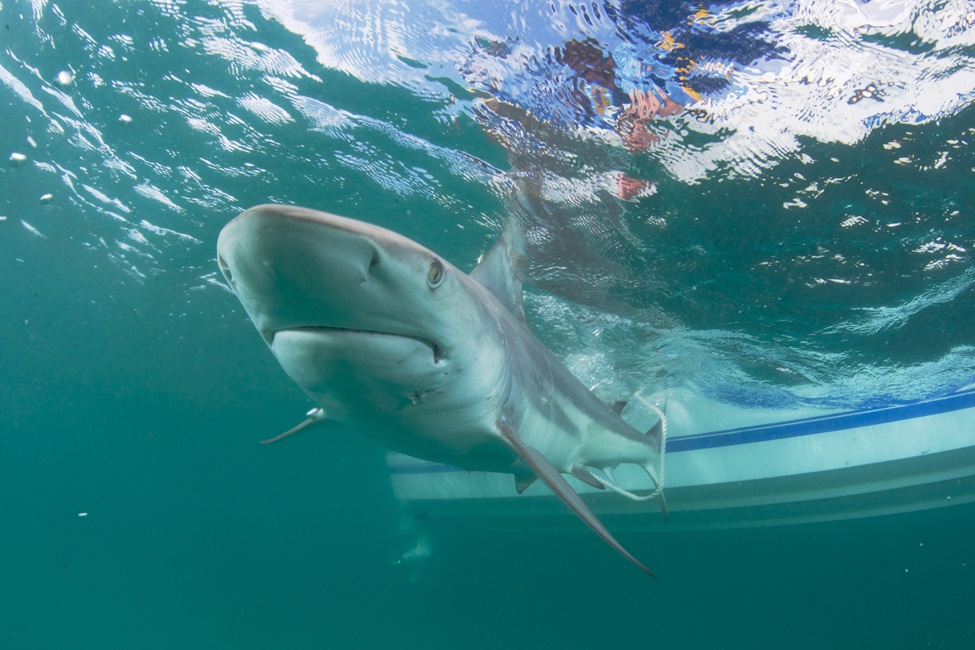How Do You Know Where a Fish Goes?

The highly migratory blacktip shark (Carcharhinus limbatus).
When scientists want to study the long-distance movement of marine animals, they will instrument them with a small device called an acoustic transmitter – or tag – which emits unique signals or “pings.” These signals are picked up by receivers anchored to the seafloor that record the date and time of each detection when the tagged animal comes within range.
Data collected by the receivers are stored until they are retrieved by researchers and shared across members of cooperative acoustic telemetry networks. This information provides valuable insights into animal behavior, migration patterns, habitat preferences and ecosystem dynamics – all of which are vital for conservation and wildlife management efforts.
However, this method is not without limitations. Receivers must be physically retrieved to access the data they have collected. For use in marine animals, receivers are often placed near the coast for easy access, but the distribution of receivers can be uneven, with some areas having few receivers and others having many. This can lead to biased data collection, especially for animals that move across large distances.
A pioneering study by researchers at Florida Atlantic University and the Smithsonian Environmental Research Center addresses these limitations by filling in the gaps in sporadic detection data and tackles the tradeoff between spatial coverage and cost. Using a movement model, researchers reconstructed animal tracks and leveraged an iterative process to measure the accuracy and precision of these reconstructions from acoustic telemetry data.
Results of the study, published in the journal Methods in Ecology and Evolution, demonstrate how researchers can apply these techniques and measure the accuracy and precision of the methods to their study sites.
For the study, researchers simulated animal tracks on a computer, then tested how well their method could accurately reconstruct the tracks if they received detection data only from a cooperative acoustic telemetry array. While most of the data used were simulated, they further tested their methodology with data from highly migratory blacktip sharks (Carcharhinus limbatus) to demonstrate how this method can be applied ecologically.
Findings demonstrate that their novel method can improve track reconstruction, even in regions with uneven receiver coverage. The track reconstruction methods performed well in coastal regions from Palm Beach County to Long Island, minimizing the clustering effect of high densities of receivers and closing the gaps in some regions that were lacking receiver coverage. Performance was primarily affected by the presence or absence of receivers, and to a lesser extent by receiver density and water depth, depending on the grid resolution.
“Our approach could significantly reduce gaps in data collection and improve the reliability of ecological insights,” said Beth Bowers, Ph.D., senior author and a post-doctoral researcher at the Smithsonian Environmental Research Center, who conducted the research as a Ph.D. student with her mentor, Stephen Kajiura, Ph.D., in FAU’s Charles E. Schmidt College of Science. “Importantly, this method doesn’t rely on costly field techniques such as motorboat towed tests, which makes it suitable for large-scale studies across diverse habitats.”
This new method increases the utility of acoustic telemetry technology and provides a framework for future studies to assess the accuracy and precision of animal movement calculated from track reconstructions that use acoustic telemetry.
“Results from our study will enable resource managers and others to infer the reliability of ecological results in their decision-making processes,” said Kajiura, co-author and a professor of biological sciences, FAU College of Science.
To foster collaboration and innovation, the researchers have made their data repository accessible, empowering fellow scientists to adapt and apply the methodology to their respective study organisms and habitats, whether that encompasses marine, freshwater or terrestrial habitats.
“Importantly, implications of our findings extend beyond marine environments, offering a transformative approach to wildlife monitoring across aquatic and terrestrial landscapes,” said Bowers.
This work was funded by the Colgan Foundation.
//
-FAU-
Latest Research
- FAU Harbor Branch Announces 2025 Ocean Science Lecture SeriesFlorida Atlantic University's Harbor Branch Oceanographic Institute announced the lineup for its annual "John & Barbara Ferrera Ocean Science Lecture Series."
- FAU's Randy D. Blakely, Ph.D., Honored as a Prestigious ASPET FellowRandy D. Blakely, Ph.D., a highly regarded neuroscientist and pharmacologist, is among an extraordinary group selected by the American Society for Pharmacology and Experimental Therapeutics.
- Study Uses AI to Interpret American Sign Language in Real-timeA first-of-its-kind FAU engineering study is breaking barriers by accurately capturing complex hand gestures in sign language using computer vision.
- FAU Engineering Wins Esteemed JFM 'Emerging Scholar Best Paper Prize'FAU engineering researchers have won the Journal of Fluid Mechanics' 2023 "Emerging Scholar Best Paper" award, which was selected from among nearly 400 eligible papers published in the journal.
- Wild Birds' Gut Microbiome Linked With Ornamentation, Body ConditionA study by FAU provides the first detailed insights into how gut microbiomes influence traits related to fitness in wild birds, addressing a gap in knowledge previously focused on captive animals.
- New Research Identifies Ideal AI System Types for ManagersAs managers face more pressure in implementing artificial intelligence (AI) into the workflow, a study from researchers at FAU and two other schools offers insights to help managers adapt.






